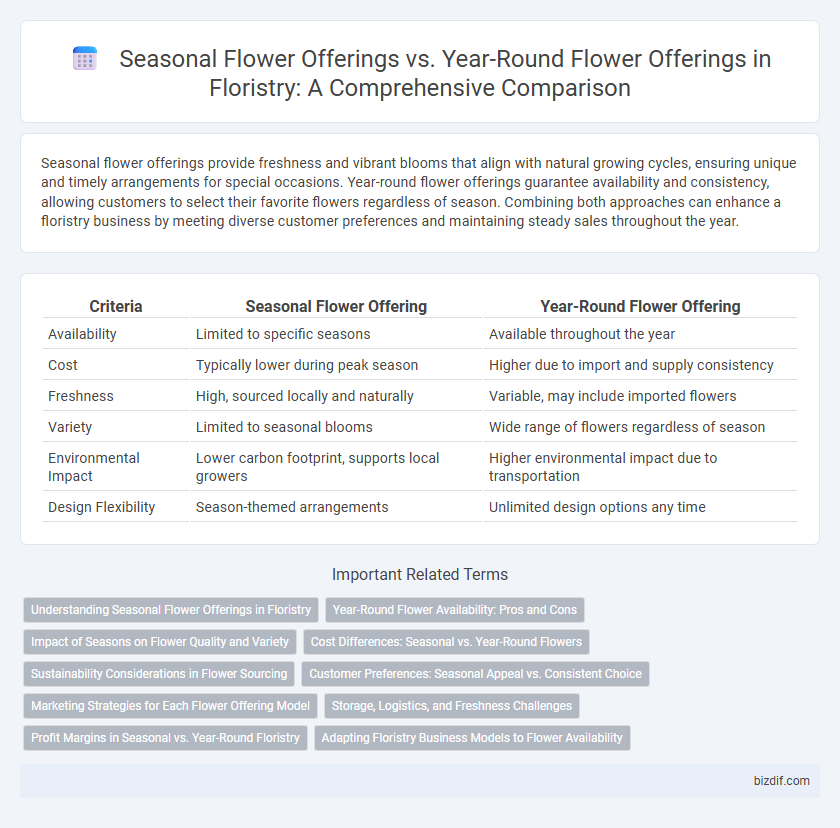Seasonal flower offerings provide freshness and vibrant blooms that align with natural growing cycles, ensuring unique and timely arrangements for special occasions. Year-round flower offerings guarantee availability and consistency, allowing customers to select their favorite flowers regardless of season. Combining both approaches can enhance a floristry business by meeting diverse customer preferences and maintaining steady sales throughout the year.
Table of Comparison
| Criteria | Seasonal Flower Offering | Year-Round Flower Offering |
|---|---|---|
| Availability | Limited to specific seasons | Available throughout the year |
| Cost | Typically lower during peak season | Higher due to import and supply consistency |
| Freshness | High, sourced locally and naturally | Variable, may include imported flowers |
| Variety | Limited to seasonal blooms | Wide range of flowers regardless of season |
| Environmental Impact | Lower carbon footprint, supports local growers | Higher environmental impact due to transportation |
| Design Flexibility | Season-themed arrangements | Unlimited design options any time |
Understanding Seasonal Flower Offerings in Floristry
Seasonal flower offerings in floristry emphasize blooms that naturally flourish during specific times of the year, resulting in fresher, more vibrant arrangements with heightened scent and color intensity. These seasonal selections often align with regional climates, promoting sustainability and supporting local growers, while reducing transportation emissions compared to year-round flower imports. Understanding seasonal availability enables florists to create unique, cost-effective designs that resonate with cultural events and ecological cycles, contrasting with the higher costs and environmental impact associated with non-seasonal, year-round flower sourcing.
Year-Round Flower Availability: Pros and Cons
Year-round flower availability ensures a consistent supply of popular blooms like roses, lilies, and carnations, enhancing customer satisfaction and enabling stable pricing. However, it often relies on imported flowers, which can increase costs and environmental impact compared to seasonal, locally grown options. Florists must balance the demand for variety and availability with sustainability and cost-effectiveness when offering flowers throughout the year.
Impact of Seasons on Flower Quality and Variety
Seasonal flower offerings provide superior quality and freshness due to natural blooming cycles, resulting in more vibrant colors and stronger fragrances. Year-round flower availability often relies on greenhouse cultivation or imported flowers, which may sacrifice some natural resilience and increase costs. Seasonal variations also influence the variety available, limiting choices in off-peak months but promoting sustainability and alignment with local ecosystems.
Cost Differences: Seasonal vs. Year-Round Flowers
Seasonal flowers often cost less due to local availability and lower transportation expenses compared to year-round flowers that require imports and controlled growing conditions. Year-round flower offerings typically involve higher labor and energy costs to maintain constant supply, impacting overall retail prices. Florists balance these cost variations by adjusting pricing strategies based on supply chain complexities and demand fluctuations throughout the year.
Sustainability Considerations in Flower Sourcing
Seasonal flower offerings prioritize locally grown blooms, reducing carbon footprints by minimizing transportation and supporting regional ecosystems. Year-round flower availability often relies on imports and greenhouse cultivation, increasing energy consumption and environmental impact. Choosing seasonal flowers enhances sustainability by promoting biodiversity and lowering resource use in floristry.
Customer Preferences: Seasonal Appeal vs. Consistent Choice
Seasonal flower offerings attract customers seeking freshness and unique blooms tied to specific times of the year, enhancing their emotional connection through timely aesthetics. Year-round flower offerings cater to those valuing consistency and reliability in availability, ensuring favorite flowers are always within reach. Understanding these preferences helps florists tailor their inventory, balancing seasonal appeal with dependable choices to maximize customer satisfaction and sales.
Marketing Strategies for Each Flower Offering Model
Marketing strategies for seasonal flower offerings emphasize timeliness by highlighting limited availability and unique freshness, creating urgency through seasonal promotions and holiday tie-ins. Year-round flower offerings rely on consistent brand messaging that assures reliability and convenience, using subscription services and loyalty programs to maintain steady customer engagement. Leveraging data analytics allows florists to tailor inventory and personalized marketing campaigns, optimizing sales for both seasonal peaks and continuous demand.
Storage, Logistics, and Freshness Challenges
Seasonal flower offerings require optimized storage solutions to handle fluctuating availability and maintain peak freshness during limited harvesting periods. Year-round flower offerings involve complex logistics to source blooms globally, demanding advanced cold chain transportation to preserve quality and extend shelf life. Both approaches face challenges in balancing freshness, timely delivery, and minimizing spoilage to meet customer expectations in the floristry industry.
Profit Margins in Seasonal vs. Year-Round Floristry
Seasonal flower offerings typically yield higher profit margins due to lower sourcing costs and the ability to capitalize on peak demand. Year-round flower offerings require consistent inventory investment and often incur higher import or greenhouse cultivation expenses, reducing overall profitability. Florists focusing on seasonal selections can optimize margins by aligning with natural bloom cycles and local availability.
Adapting Floristry Business Models to Flower Availability
Seasonal flower offerings reflect natural bloom cycles, allowing florists to optimize costs and showcase local varieties, enhancing sustainability and freshness. Year-round flower offerings require establishing reliable supply chains, often involving imported or greenhouse-grown flowers, ensuring consistent availability for diverse client needs. Adapting floristry business models involves balancing these approaches to manage inventory effectively while aligning with market demand and environmental considerations.
Seasonal flower offering vs year-round flower offering Infographic

 bizdif.com
bizdif.com